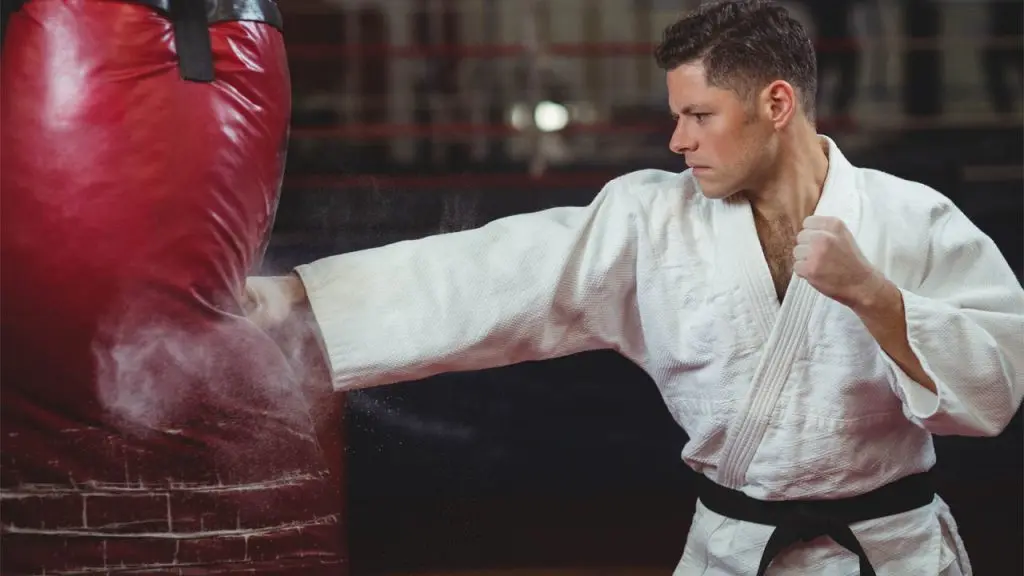When you think of a punching bag, what’s the first martial art that pops into your head?
For most of us, it is probably boxing.
But boxers aren’t the only athletes who can benefit from punching bag workouts. In fact, punching bag workouts are an excellent way to hone other martial arts skills, for instance Kickboxing, Karate, Muay Thai, MMA, Taekwondo.
Let’s dive in and learn all about it!
Table of Contents
Punching Bag vs Heavy Bag
Let’s start with defining some terms here. You’ll often hear the terms punching bag and heavy bag interchangeably, they are not the same thing. All heavy bags are punching bags, but not all punching bags are heavy bags.
In other words, a heavy bag is a type of punching bag and the most relevant to our discussion. The classic heavy bag is about 4 – 5 feet long and hangs from the ceiling. The weight can vary between 30 and 200 pounds.
Heavy bags are supposed to be heavy (hence the name) and absorb your strikes without moving around too much. A good rule of thumb to go by when choosing a heavy bag is to pick one that is roughly half your body weight. The main thing is to choose something with some heft. If the bag flies around wildly every time you touch it, you’ll spend your whole workout waiting for the bag to re-center itself.
Heavy bags are typically cylindrical in shape, though some come with contouring to mimic the shape of the human body. This allows you to better practice more advanced techniques like hooks and uppercuts.
Other types of punching bags include those little hanging teardrop-shaped speed bags boxers use to get faster and banana bags that are taller and more slender. These can be useful if you want to incorporate low kicks into your workout.
Freestanding bags are also useful because they are easier to store and perfect for people who don’t have a place to hang a heavy bag in their homes. The base is filled with sand or perhaps water. You can roll them out easily for a workout and then back up against the wall for storage, making them a great option for home gyms.
Why Use a Punching Bag for Martial Arts Training?
Punching bag workouts are excellent for conditioning and strengthening various muscle groups in your body. Even if you only strike the punching bag with your hands, you’ll use muscles all over your body. This includes the lower body as you add a hip twist to maximize power.
Using a punching bag also helps you practice your stances. You’ll get a much better idea of how stable your stances are when you meet resistance.
Not to mention that if you want to hit harder, you’ve to practice hitting something. You can do kata and practice drills until you are blue in the face. However, you won’t activate the deep muscles that allow you to hit powerfully until you actually hit something.
Preparing for Punching Bag Training
You can’t just get a heavy bag and start beating the crap out of it. That’s a good way to beat the crap out of yourself all by yourself.
Instead, get a good pair of 12 or 14-ounce boxing gloves and a set of hand wraps. Both these pieces of equipment are integral to preventing injury while you are training with a punching bag. Wondering how to properly wrap your hands? Check out this easy-to-follow visual demonstration here.
How to Use a Punching Bag
Until you know how to use a punching bag properly, it’s a good idea to train with someone who does. Using the bag improperly is a recipe for disaster as you can easily break bones in your hands, wrists, or forearms.
The best way to protect yourself is to not let your training go out the window. If you are a karate enthusiast, remember, this is a karate bag training session. You might be tempted to just start pounding away like a boxer with a new toy but that won’t be as effective for what you want to do. Boxing and karate are two different sports and practitioners use this same training tool a little differently.
Execute each technique with the same precision and control you would use when training Kata or Kumite. Hit the bag with your whole body, not just your hand or foot (or whichever part of your body comes into contact with the bag).
When punching, drive the index and middle finger knuckles into the bag, even with the gloves on. You are probably already aware that these are the strongest knuckles because they have the support of the forearm bones behind them. Plus, a straight wrist helps ensure no broken bones or pulled muscles in your hands and arms.
Strike, don’t push the bag. If you notice that your bag is swinging a lot, you’re probably pushing it rather than hitting it. Powerful punches will get the bag moving, but it should jerk and stay within a relatively small area rather than go flying off like a kid on a swing.
Always watch your distance from the bag. Striking the punching bag from the wrong distance at best results in an ineffective strike, at worst you could injure yourself.
To get the best results, put the same spirit and focus you would put into your regular muay thai/mma/karate/taekwondo training drills. Be mindful of each move and choose your techniques rather than just wildly throwing punches.
5 Excellent Punching Bag Workouts
So, now you’ve got your heavy bag set up. You bought your gloves and you’ve figured out how to wrap your hands. What are some good punchbag drills you can use? Let’s look at a few.
1. Full Body Martial Arts Bag Workout
This circuit workout is an excellent way to engage all the muscles in your body. If you perform this routine consistently, get ready to get ripped and substantially increase your punching and kicking power.
To perform the circuit, execute all the techniques with no rest. Once you’ve completed the circuit, rest for 30 seconds to complete one round. Aim to complete 5 rounds during your workout session. Ready? Here goes!
- Right low kick: 5 reps
- Right high kick: 5 reps
- Left low kick: 5 reps
- Left high kick: 5 reps
- Straight punches, alternating hands: 20 reps
- Left hook: 5 reps
- Right hook: 5 reps
- Knee strikes: 5 reps on each side
Remember, every technique should be performed with precision. Watch your stances and balance and maintain the correct distance from the bag.
2. Straight Punch Burpee Workout
Everybody loves burpees — when they’re not doing them. Burpees are one of the most effective full-body movements for working the whole body and burning fat. However, you really feel them as you’re doing them.
To do the straight punch burpee workout, set yourself a 3-minute round. Do 20 straight punches, alternating hands. Then do a burpee.
Not sure how to do one? Start in a neutral position with your feet shoulder-width apart. Squat down and place your hands on the ground. Shoot your legs back behind you so that you end up in a pushup position. While you’re there, go ahead and do a pushup. Jump to bring your feet back up by your hands, stand, and jump straight up in the air.
Some people modify the burpees by eliminating the upward jump and the pushup (or both). However, you’ll get the best workout if you aim to do the whole movement.
Keep alternating 20 straight punches with one burpee. When you have 10 seconds left, start slamming those straight punches as fast as you can. When the timer beeps, do 5 burpees.
After a short rest, rinse and repeat.
3. The 30-30-30 Punching Bag Workout
Again, set a 3-minute round. This workout is a classic boxing drill that involves three punching styles that you perform for 30 seconds each. You’ll do the whole circuit twice once the round ends.
For the first 30 seconds, straight punch the bag at a normal speed. The second 30 seconds you’ll punch with short quick jabs while “jogging” in place (but bringing your knees up in front of you). The last 30 seconds are for your strongest punches. Every one of them is a knockout-worthy strike.
Here’s a great demonstration of how to do this.
4. Perfecting the Technique
If you’ve been practicing boxing/karate/mma/muay thai/kickboxing for any length of time, you know that drills are an important part of training. They might not be the most fun part of the class, but they are integral for honing your skills and perfecting your technique.
Well, you can do the same drills with a punching bag.
Try working your roundhouse kick for 3 minutes, 1.5 minutes on each side or switch every 30 seconds. You don’t have to do them fast, but be methodical and don’t lollygag. Put a lot of thought into each movement, ensuring that you perform the technique well, without losing your balance.
This training method is effective with any striking technique, low kicks, high kicks, hook kicks, sidekicks, straight punches, and more. We guarantee that after a few rounds of this, your muscles will be screaming for a break!
5. Punching Bag Combos Workout
After you’ve drilled your techniques to perfection, it’s time to start combining them. After all, a perfect technique likely won’t do you much good by itself. Combos are where it’s at for learning to effectively take down an opponent.
Practicing combos with a punching bag gives you a better idea of what it feels like to use these techniques on a person. Plus, you’ll be developing your power and strengthening the necessary muscles at the same time.
Here are some effective combos you can implement. Do each technique in the combo once and keep going until your round is up.
- Front kick with the front leg – jab – cross
- Roundhouse kick with the front leg – cross – hook
- Front kick with the back leg – cross – hook with the front hand
- Jab – cross – roundhouse kick with the back leg
- Sidekick with the front leg – cross – cross
This video gives a precise demonstration of what this should look like.
The Benefits of a Karate Bag Training
Punching bag workouts aren’t just for boxers and kickboxers. They are an effective training tool for karatekas and other styles of martial arts as well.
When you perform punching bag workouts often, you’ll discover a number of benefits beyond the greater striking power and better balance that we’ve already touched on.
For example, if you’ve only ever struck the air, you might notice that your breathing is off when you start punching the bag. You kiai at times with your strikes, which helps to ensure that you breathe properly, but it doesn’t happen every time.
When you are actually hitting something, your body begins to adjust. Over time, you naturally begin to breathe correctly, further channeling more power into your punches and kicks.
Working self-defense skills with a punching bag will also improve your form. Sloppy form when you strike the air is one thing — hit a punching bag incorrectly and you’ll know it. You might even feel it for a few days afterward.
Furthermore, all these drills will only serve to improve your core strength. Core muscles are integral to virtually everything you do as a martial artist.
Level Up Your Skills
Punching bag workouts aren’t the only way to train harder and smarter. There are plenty of other ways to level up your martial arts skills. To get started, check out this article on how to improve your karate skills faster.


